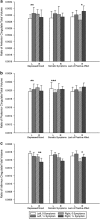Dimensions of depressive symptoms and cingulate volumes in older adults
- PMID: 27093070
- PMCID: PMC4872407
- DOI: 10.1038/tp.2016.49
Dimensions of depressive symptoms and cingulate volumes in older adults
Abstract
Clinical depression and subthreshold depressive symptoms in older adults have been linked to structural changes in the cingulate gyrus. The cingulate comprises functionally distinct subregions that may have distinct associations with different types, or symptom dimensions, of depression. This study examined the relationship between symptom dimensions of depression and gray matter volumes in the anterior cingulate, posterior cingulate and isthmus of the cingulate in a nonclinical sample. The study included 41 community-dwelling older adults between the ages of 55 and 81. Participants received a structural magnetic resonance imaging scan and completed the Center for Epidemiologic Studies Depression Scale. Subscale scores for depressed mood, somatic symptoms and lack of positive affect were calculated, and Freesurfer was used to extract cingulate gray matter volumes. Regression analyses were conducted to examine the relationship between depressive symptoms and volumes of cingulate subregions while controlling for sex, age and estimated total intracranial volume. Higher scores on the depressed mood subscale were associated with larger volumes in the left posterior cingulate and smaller volumes in the isthmus cingulate. Higher scores on the somatic symptoms subscale were significantly related to smaller volumes in the posterior cingulate. A trend was observed for a positive relationship between higher scores on the lack of positive affect subscale and larger volumes in the anterior cingulate cortex. These results are consistent with previous findings of altered cingulate volumes with increased depressive symptomatology and suggest specific symptom dimensions of depression may differ in their relationship with subregions of the cingulate.
Figures

Similar articles
-
Vertex-wise examination of depressive symptom dimensions and brain volumes in older adults.Psychiatry Res Neuroimaging. 2017 Feb 28;260:70-75. doi: 10.1016/j.pscychresns.2016.12.008. Epub 2016 Dec 16. Psychiatry Res Neuroimaging. 2017. PMID: 28039796 Free PMC article.
-
Orbitofrontal and Cingulate Thickness Asymmetry Associated with Depressive Symptom Dimensions.Cogn Affect Behav Neurosci. 2021 Dec;21(6):1297-1305. doi: 10.3758/s13415-021-00923-8. Epub 2021 Jun 16. Cogn Affect Behav Neurosci. 2021. PMID: 34136976
-
Linking depressive symptom dimensions to cerebellar subregion volumes in later life.Transl Psychiatry. 2020 Jun 19;10(1):201. doi: 10.1038/s41398-020-00883-6. Transl Psychiatry. 2020. PMID: 32561707 Free PMC article.
-
Cortical and Subcortical Gray Matter Volume in Youths With Conduct Problems: A Meta-analysis.JAMA Psychiatry. 2016 Jan;73(1):64-72. doi: 10.1001/jamapsychiatry.2015.2423. JAMA Psychiatry. 2016. PMID: 26650724 Review.
-
Cingulate-mediated depressive symptoms in neurologic disease and therapeutics.Handb Clin Neurol. 2019;166:371-379. doi: 10.1016/B978-0-444-64196-0.00021-2. Handb Clin Neurol. 2019. PMID: 31731923 Review.
Cited by
-
Neuroanatomical Correlates of the Late Positive Potential in Youth with Pediatric Bipolar Disorder.Curr Neuropharmacol. 2023;21(7):1617-1630. doi: 10.2174/1570159X21666230413104536. Curr Neuropharmacol. 2023. PMID: 37056060 Free PMC article.
-
Disrupted small-world architecture and altered default mode network topology of brain functional network in college students with subclinical depression.BMC Psychiatry. 2025 Mar 3;25(1):193. doi: 10.1186/s12888-025-06609-6. BMC Psychiatry. 2025. PMID: 40033273 Free PMC article.
-
Neurobiological and genetic correlates of the dissociative subtype of posttraumatic stress disorder.J Psychopathol Clin Sci. 2023 May;132(4):409-427. doi: 10.1037/abn0000795. Epub 2023 Apr 6. J Psychopathol Clin Sci. 2023. PMID: 37023279 Free PMC article.
-
Brain structural correlates of irritability: Findings in a large healthy cohort.Hum Brain Mapp. 2017 Dec;38(12):6230-6238. doi: 10.1002/hbm.23824. Epub 2017 Sep 25. Hum Brain Mapp. 2017. PMID: 28945310 Free PMC article.
-
Hippocampal Volume as a Putative Marker of Resilience or Compensation to Minor Depressive Symptoms in a Nonclinical Sample.Front Psychiatry. 2019 Jul 12;10:467. doi: 10.3389/fpsyt.2019.00467. eCollection 2019. Front Psychiatry. 2019. PMID: 31354542 Free PMC article.
References
-
- Naismith SL, Norrie LM, Mowszowski L, Hickie IB. The neurobiology of depression in later-life: clinical, neuropsychological, neuroimaging and pathophysiological features. Prog Neurobiol 2012; 98: 99–143. - PubMed
-
- Kumar A, Schweizer E, Zhisong J, Miller D, Bilker W, Swan LL et al. Neuroanatomical substrates of late-life minor depression: a quantitative magnetic resonance imaging study. Arch Neurol 1997; 54: 613–617. - PubMed
-
- Taki Y, Kinomura S, Awata S, Inoue K, Sato K, Ito H et al. Male elderly subthreshold depression patients have smaller volume of medial part of prefrontal cortex and precentral gyrus compared with age-matched normal subjects: a voxel-based morphometry. J Affect Disord 2005; 88: 313–320. - PubMed
Publication types
MeSH terms
Grants and funding
LinkOut - more resources
Full Text Sources
Other Literature Sources

